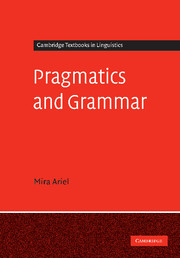Book contents
- Frontmatter
- Contents
- List of tables
- Preface
- Acknowledgments
- How to use this book
- Transcription conventions
- 1 Introduction: Grammar, pragmatics, and what's between them
- PART I Drawing the grammar/pragmatics divide
- PART II Crossing the extralinguistic/linguistic divide
- 4 Grammar, pragmatics, and arbitrariness
- 5 All paths lead to the salient discourse pattern
- 6 The rise (and potential fall) of reflexive pronouns
- Part III Bringing grammar and pragmatics back together
- References
- Author index
- Subject index
5 - All paths lead to the salient discourse pattern
Published online by Cambridge University Press: 05 September 2012
- Frontmatter
- Contents
- List of tables
- Preface
- Acknowledgments
- How to use this book
- Transcription conventions
- 1 Introduction: Grammar, pragmatics, and what's between them
- PART I Drawing the grammar/pragmatics divide
- PART II Crossing the extralinguistic/linguistic divide
- 4 Grammar, pragmatics, and arbitrariness
- 5 All paths lead to the salient discourse pattern
- 6 The rise (and potential fall) of reflexive pronouns
- Part III Bringing grammar and pragmatics back together
- References
- Author index
- Subject index
Summary
Consider a simple example, provided by Langacker (2000). It is quite obvious, he argues, that the suddenly needed term for a ‘computer device’ mouse was derived from the word's literal ‘rodent’ meaning. It's equally uncontroversial that when first used for the new instantiation, it was through pragmatic inferencing that the new interpretation was derived. Of course, nowadays, mouse is already semantically ambiguous (polysemous) between the two meanings. The computer-device meaning is part of our conventional, grammatical knowledge of the lexeme mouse. Note that it has a different plural form (mouses), and it can serve as the basis for yet a new derived interpretation, as in (1), where clitoris mouse refers to the small, centrally located pointing stick used as a mouse on some laptop computers:
(1) A: It's got a clitoris mouse.
B: It's got a what.
(LSAC)But when/where/how did the change in cognitive status happen for mouse? It did not come about by stipulation. All we can assume is that many speakers started using this innovation because they found it useful, not because they were seeking to change their lexicon. But when did the change actually take place? On the first uses it may not have been easy to even understand (witness B's difficulty in (1)). On the seventh use event of the metaphoric mouse, asks Langacker? We cannot determine a precise moment when the inference leading from ‘rodent mouse’ to ‘computer mouse’ gave way to a conventional, semantic meaning for mouse (see Deutscher, 2005: 152).
- Type
- Chapter
- Information
- Pragmatics and Grammar , pp. 149 - 211Publisher: Cambridge University PressPrint publication year: 2008



